2019 MERCEDES-BENZ SLC ROADSTER lights
[x] Cancel search: lightsPage 48 of 306
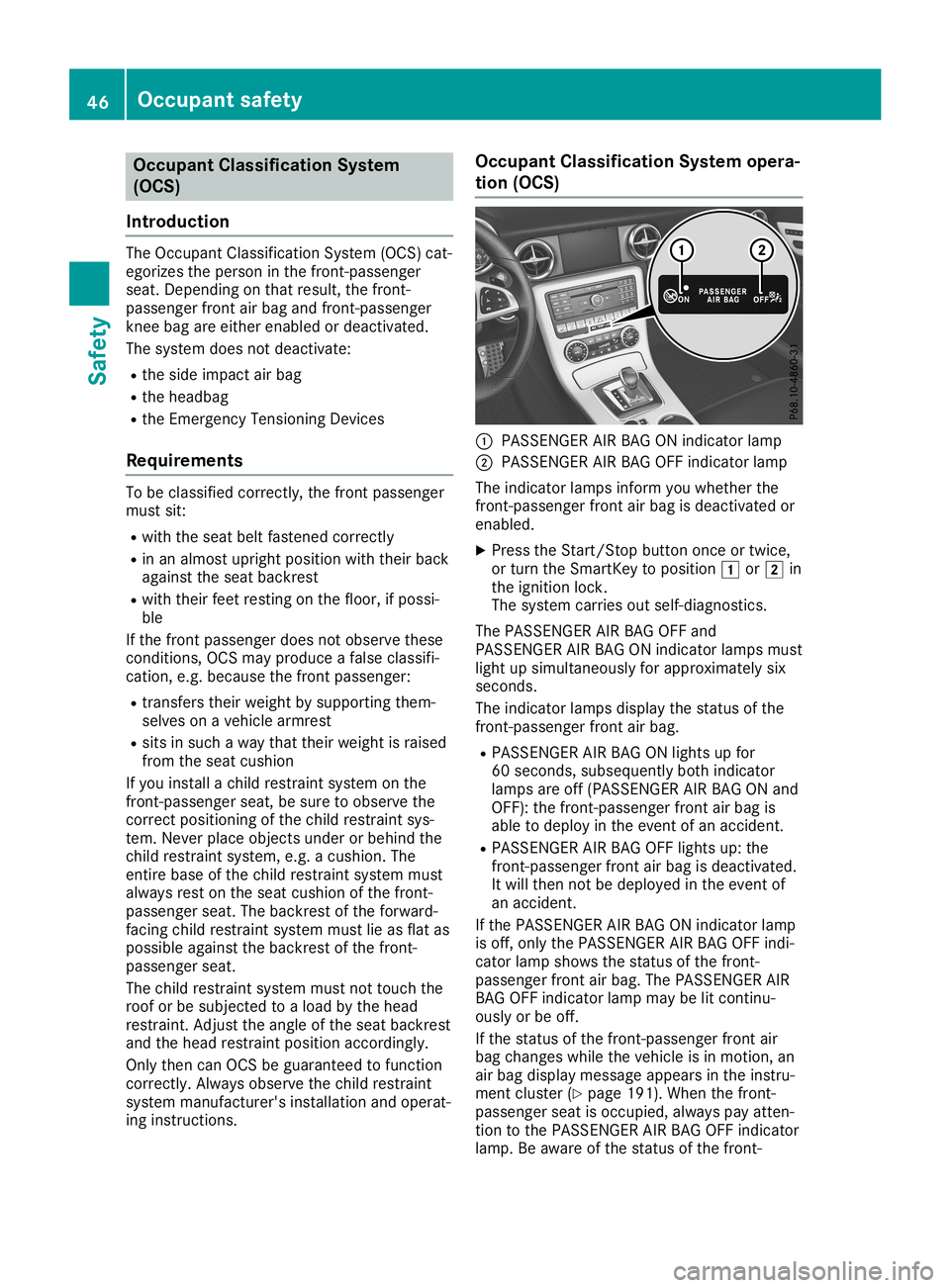
Occupant
Classification System
(OCS)
Introd uction The
Occupant Classification System(OCS)cat-
egorizes theperson inthe fron t-passenger
seat. Depen dingonthat result, thefron t-
passenger frontair bag and front-passenger
kn ee bag areeither enabled ordeactivat ed.
The system doesnotdeactivat e:
R the side impact airbag
R the headbag
R the Emer gencyTension ingDevic es
Requ irement s To
be classified correctly,the fron tpassenger
must sit:
R with theseat beltfasten edcorr ectly
R in an almost upright position withtheir back
against theseat backr est
R with their feetrestin gon the floor, ifpossi-
ble
If the fron tpassenger doesnotobserve these
con ditions ,OCS mayproduce afalse classifi-
cation ,e.g. because thefron tpassenger:
R tran sfers theirweight bysupportin gthem-
selves onavehicle armrest
R sits insuch away that their weight israised
from theseat cushion
If you installachild restraint system onthe
fron t-passenger seat,besure toobserve the
corr ectposition ingofthe child restraint sys-
tem. Never placeobjectsunder orbehind the
child restraintsystem, e.g.acushion. The
ent irebase ofthe child restraint system must
alway srest onthe seat cushion ofthe fron t-
passenger seat.Thebackr estofthe forward-
facing childrestraint system mustlieasflat as
possible againstthebackr estofthe fron t-
passenger seat.
The child restraintsystem mustnottouch the
roof orbe subject edtoaload bythe head
rest raint .Adj ust the angle ofthe seat backr est
and thehead restraintposition accordingly.
Only thencanOCS beguaranteed tofunc tion
corr ectly.Always observe thechild restraint
system manufact urer'sinstallation andoperat-
ing inst ruct ions. Occupant
Classification Systemopera-
tion (OCS) 0043
PAS SENGER AIRBAG ONindicat orlamp
0044 PAS SENGER AIRBAG OFFindicat orlamp
The indicat orlamps informyou whether the
fron t-passenger frontair bag isdeactivat edor
enabled.
X Press theStart/ Stop button onceor twice,
or turn theSmart Keytoposition 0047or0048 in
the ignition lock.
The system carriesoutself-diagn ostics.
The PASSENGER AIRBAG OFFand
PAS SENGER AIRBAG ONindicat orlamps must
light upsimultaneously forapproximat elysix
secon ds.
The indicat orlamps display thestatusofthe
fron t-passenger frontair bag.
R PAS SENGER AIRBAG ONlights upfor
60 secon ds,subsequently bothindicat or
lamps areoff(PASS ENGERAIR BAG ONand
OFF): thefron t-passenger frontair bag is
able todeploy inthe event ofan acciden t.
R PAS SENGER AIRBAG OFFlights up:the
fron t-passenger frontair bag isdeactivat ed.
It will then notbedeployed inthe event of
an acciden t.
If the PAS SENGER AIRBAG ONindicat orlamp
is off, only thePAS SENGER AIRBAG OFFindi-
cator lampshows thestatusofthe fron t-
passenger frontair bag. ThePASSENGER AIR
BAG OFFindicat orlamp maybelitcon tinu-
ously orbe off.
If the statusofthe fron t-passenger frontair
bag changes whilethevehicle isin motion ,an
air bag display message appearsinthe instru-
ment cluster (Ypage 191). When thefron t-
passenger seatisoccupied, alwayspay atten -
tion tothe PAS SENGER AIRBAG OFFindicat or
lamp. Beaware ofthe statusofthe fron t- 46
Occupant
safetySafet y
Page 49 of 306
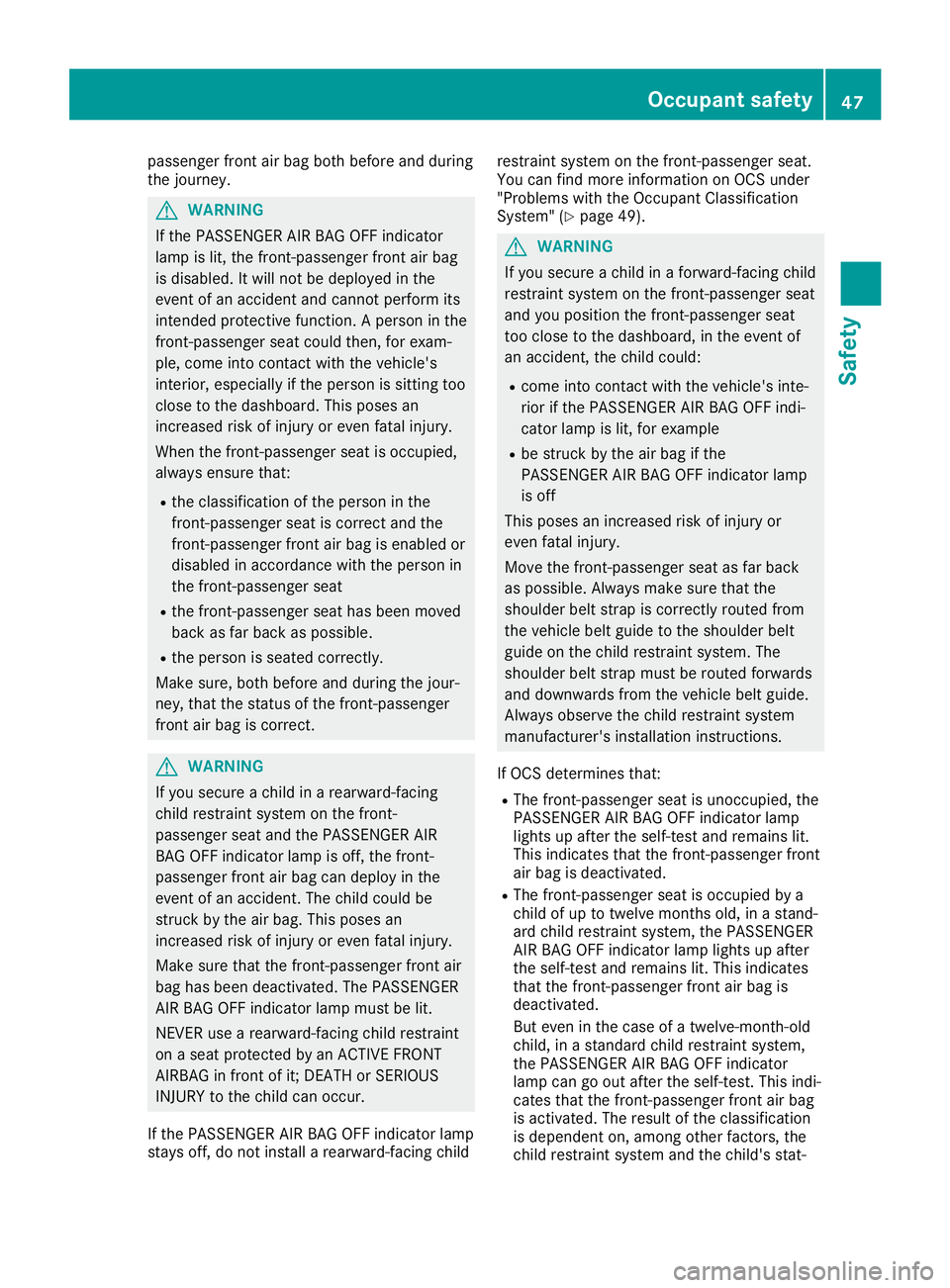
passenger
frontair bag both before andduring
the journ ey. G
WARN
ING
If the PAS SENGER AIRBAGOFF indicat or
lamp islit, the fron t-passenger frontair bag
is disabled. Itwill notbedeployed inthe
event ofan acciden tand cann otperfor mits
int ended protective func tion.A person inthe
fron t-passenger seatcould then,for exam-
ple, come intocon tact with thevehicle's
int erior, especially ifthe person issitt ing too
close tothe dashboard. Thisposes an
incr eased riskofinjury oreven fatalinjury.
When thefron t-passenger seatisocc upied,
always ensure that:
R the classific ationofthe person inthe
fron t-passenger seatiscorr ectand the
fron t-passenger frontair bag isenabled or
disabled inaccor dance withtheperson in
the fron t-passenger seat
R the fron t-passenger seathasbeen moved
back asfar back aspossible.
R the person isseated correctly.
Make sure,bothbefore andduring thejour-
ney, thatthestatusofthe fron t-passenger
fron tair bag iscorr ect. G
WARN
ING
If you secure achild inarearward-f acing
child restraint system onthe fron t-
passenger seatandthePAS SENGER AIR
BA GOFF indicat orlamp isoff, thefron t-
passenger frontair bag candeploy inthe
event ofan acciden t.The child could be
str uck bythe airbag. Thisposes an
incr eased riskofinjury oreven fatalinjury.
Make surethatthefron t-passenger frontair
bag hasbeen deactiv ated.ThePASSENGER
AIR BAGOFF indicat orlamp must belit.
NEV ERuse arearward-f acingchildrestraint
on aseat prote cted byan ACTIVE FRONT
AIRB AGinfron tof it;DE ATH orSERIOUS
INJURY tothe child canoccur.
If the PAS SENGER AIRBAGOFF indicat orlamp
stays off,donot installarearward-f acingchild rest
raint system onthe fron t-passenger seat.
You canfind more information onOCS under
"Problems withtheOcc upant Classification
System "(Y page 49). G
WARN
ING
If you secure achild inaforward- facingchild
rest raint system onthe fron t-passenger seat
and youposition thefron t-passenger seat
too close tothe dashboard, inthe event of
an acciden t,the child could:
R come intocon tact with thevehicle's inte-
rior ifthe PAS SENGER AIRBAGOFF indi-
cator lampislit, for example
R be struck bythe airbag ifthe
PAS SENGER AIRBAGOFF indicat orlamp
is off
This poses anincr eased riskofinjury or
even fatalinjury.
Move thefron t-passenger seatasfar back
as possible. Alwaysmakesurethatthe
shoulder beltstrap iscorr ectlyrouted from
the vehicle beltguide tothe shoulder belt
guide onthe child restraint system. The
shoulder beltstrap must berouted forwards
and downwards fromthevehicle beltguide.
Always observe thechild restraint system
manufact urer'sinstallation instruct ions.
If OCS determ inesthat:
R The front-passenger seatisunocc upied, the
PAS SENGER AIRBAGOFF indicat orlamp
lights upafter theself-t estand remains lit.
This indicat esthat thefron t-passenger front
air bag isdeactiv ated.
R The front-passenger seatisocc upied bya
child ofup totwelve monthsold, inastan d-
ard child restraint system, thePAS SENGER
AIR BAGOFF indicat orlamp lights upafter
the self-t estand remains lit.This indicat es
that thefron t-passenger frontair bag is
deactiv ated.
But even inthe case ofatwelve- month-old
child, inastan dard child restraint system,
the PAS SENGER AIRBAGOFF indicat or
lamp cangoout after theself-t est.This indi-
cates thatthefron t-passenger frontair bag
is activ ated. Theresult ofthe classific ation
is dependen ton, among otherfactors, the
child restraint system andthechild's stat- Occupant
safety
47Safet y Z
Page 51 of 306
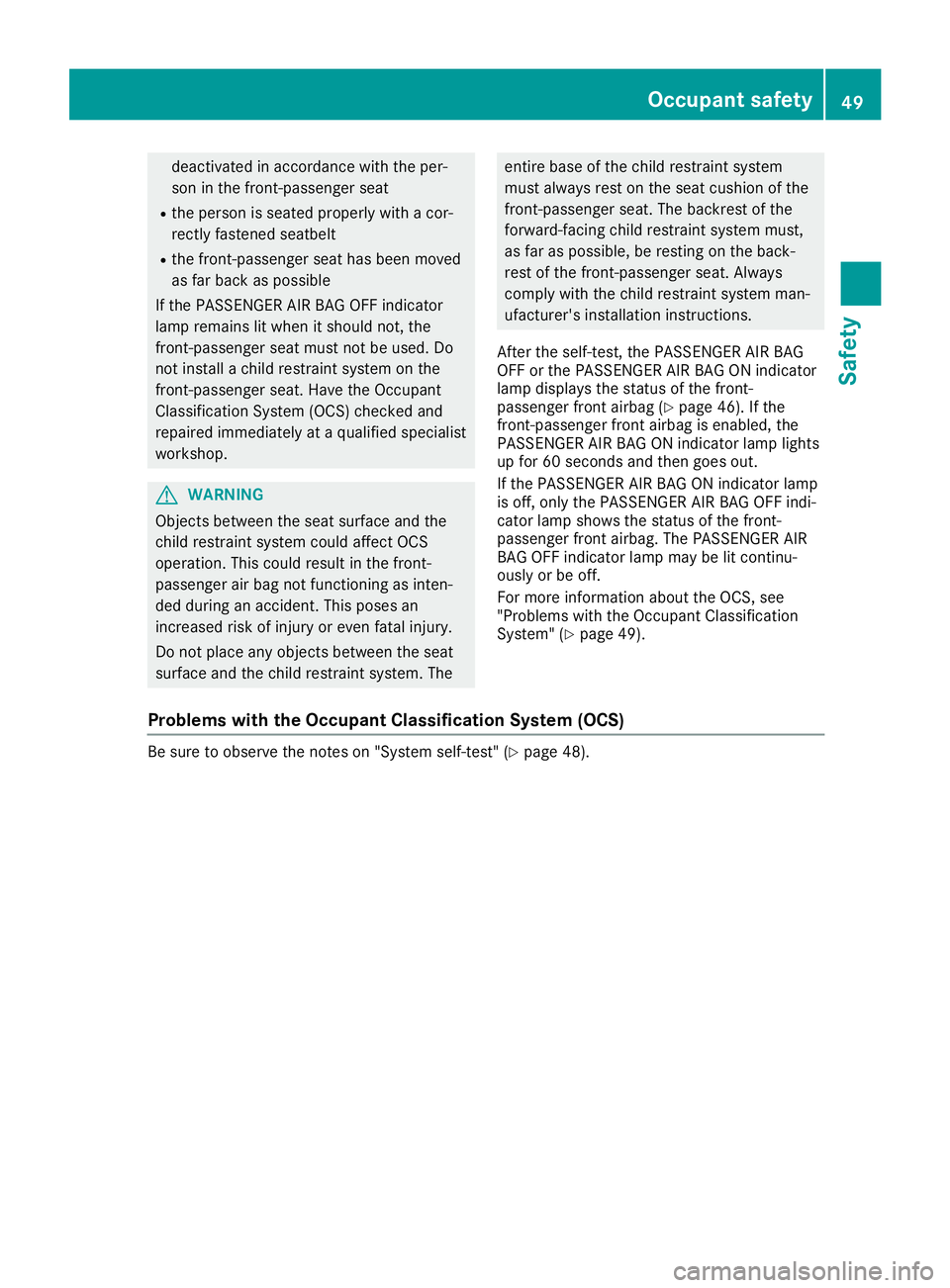
deactiv
atedinaccor dance withtheper-
son inthe fron t-passenger seat
R the person isseated properly withacor-
rect lyfasten edseatbelt
R the fron t-passenger seathasbeen moved
as far back aspossible
If the PAS SENGER AIRBAGOFF indicat or
lamp remains litwhen itshould not,the
fron t-passenger seatmust notbeused. Do
not installachild restraint system onthe
fron t-passenger seat.Have theOcc upant
Classification System(OCS)checkedand
repaired immediately ataqualified specialist
worksh op. G
WARN
ING
Objec tsbetween theseat surface andthe
child restraint system couldaffect OCS
operation .This could result inthe fron t-
passenger airbag notfunc tioningasinten-
ded during anacciden t.This poses an
incr eased riskofinjury oreven fatalinjury.
Do not place anyobjec tsbetween theseat
surface andthechild restraint system. The ent
irebase ofthe child restraint system
must always restonthe seat cushion ofthe
fron t-passenger seat.Thebackr estofthe
forward- facingchild restraint system must,
as far aspossible, berest ingonthe back-
rest ofthe fron t-passenger seat.Always
comply withthechild restraint system man-
ufactur er'sinstallation instruct ions.
Aft erthe self-t est,thePAS SENGER AIRBAG
OFF orthe PAS SENGER AIRBAGON indicat or
lamp displays thestatusofthe fron t-
passenger frontairbag (Ypage 46).Ifthe
fron t-passenger frontairbag isenabled, the
PAS SENGER AIRBAGON indicat orlamp lights
up for 60secon dsand then goes out.
If the PAS SENGER AIRBAGON indicat orlamp
is off, only thePAS SENGER AIRBAGOFF indi-
cator lampshows thestatusofthe fron t-
passenger frontairbag. ThePASSENGER AIR
BA GOFF indicat orlamp maybelitcon tinu-
ously orbe off.
For more information abouttheOCS, see
"Problems withtheOcc upant Classification
System "(Y page 49).
Problems withtheOccupant Classification System(OCS) Be
sure toobserve thenoteson "System self-test"(Ypage 48). Occupant
safety
49Safet y Z
Page 52 of 306
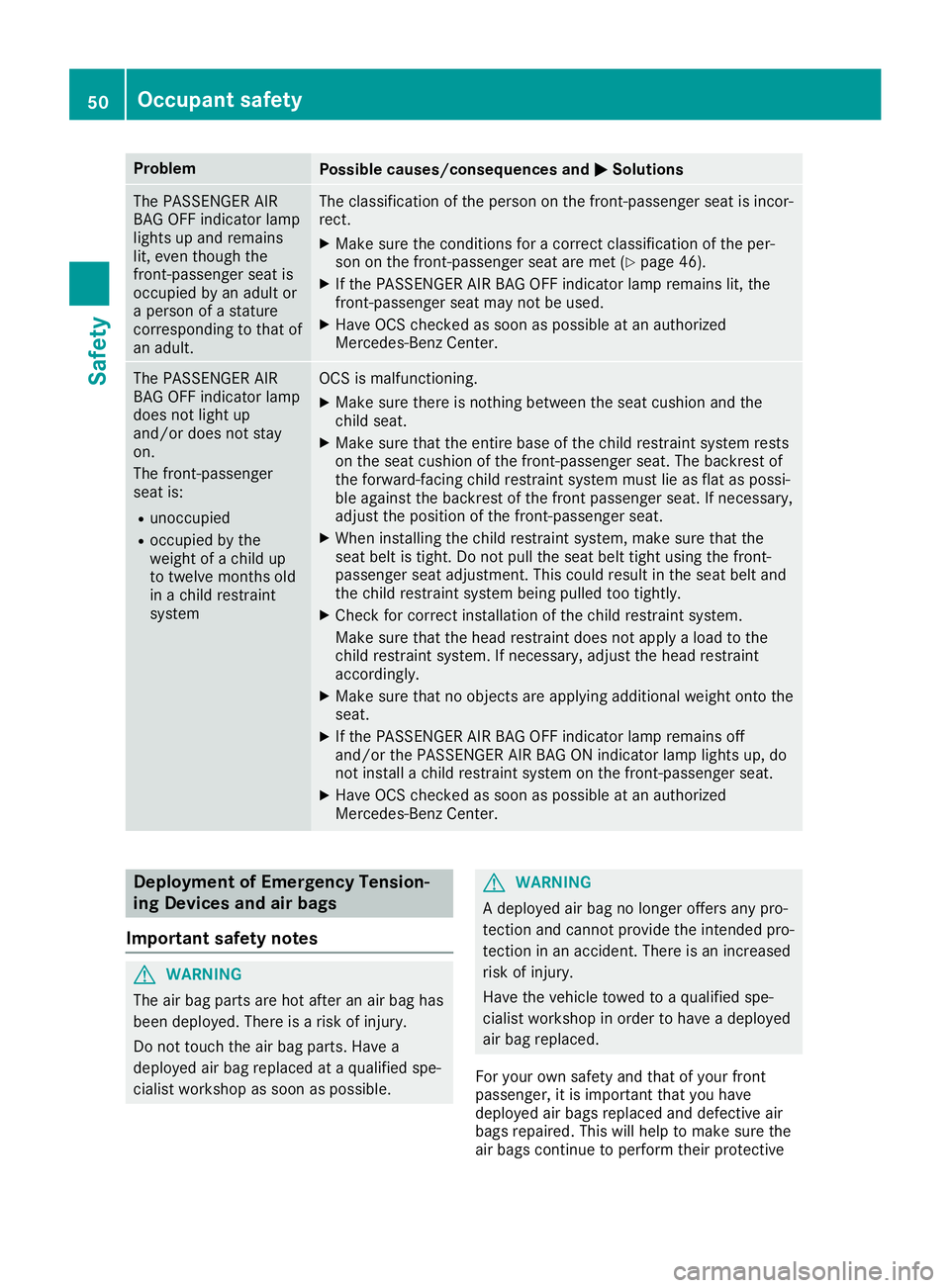
Problem
Possible
causes/co nsequences and0050 0050
Solutions The
PASS ENGER AIR
BAG OFFindicator lamp
lights upand remains
lit, even though the
front -passenger seatis
occupied byan adult or
a person ofastature
correspondin gto that of
an adult. The
classification ofthe person onthe front -passenger seatisincor-
rect.
X Make surethecondition sfor acorrect classification ofthe per-
son onthe front -passenger seataremet (Ypage 46).
X Ifthe PASS ENGER AIRBAG OFFindicator lampremains lit,the
front -passenger seatmaynotbeused.
X Have OCScheck edassoon aspossible atan authorized
Mercedes-Ben zCenter. The
PASS ENGER AIR
BAG OFFindicator lamp
does notlight up
and/or doesnotstay
on.
The front -passenger
seat is:
R unoccupied
R occupied bythe
weight ofachild up
to twelve monthsold
in achild restraint
system OCS
ismalfunctionin g.
X Make surethere isnothin gbetween theseat cushion andthe
child seat.
X Make surethattheentire baseofthe child restraint systemrests
on the seat cushion ofthe front -passenger seat.Thebackrest of
the forward-facing childrestraint systemmustlieasflat aspossi-
ble against thebackrest ofthe front passenger seat.Ifnecessary,
adjust theposition ofthe front -passenger seat.
X When installing thechild restraint system,makesurethatthe
seat beltistight. Donot pull theseat belttight using thefront -
passenger seatadjustment .This could result inthe seat beltand
the child restraint systembeingpulled tootightly.
X Check forcorrect installation ofthe child restraint system.
Make surethatthehead restraint doesnotapply aload tothe
child restraint system.Ifnecessary, adjustthehead restraint
accordingly.
X Make surethatnoobject sare apply ingadditional weightontothe
seat.
X Ifthe PASS ENGER AIRBAG OFFindicator lampremains off
and/or thePASS ENGER AIRBAG ONindicator lamplights up,do
not install achild restraint systemonthe front -passenger seat.
X Have OCScheck edassoon aspossible atan authorized
Mercedes-Ben zCenter. Deployment
ofEmergency Tension-
ing Devic esand airbags
Import antsafety notes G
WARNING
The airbag parts arehot after anair bag has
been deploye d.There isarisk ofinjury.
Do not touch theairbag parts. Havea
deploye dair bag replaced ataquali fiedspe-
cialist workshop assoon aspossible. G
WARNING
A deploye dair bag nolonger offersanypro-
tect ionand cannot provide theinten dedpro-
tect ioninan accident. Thereisan increased
risk ofinjury.
Have thevehicle towedtoaquali fiedspe-
cialist workshop inorder tohave adeploye d
air bag replaced.
For your ownsafety andthat ofyour front
passenger, itis important thatyouhave
deploye dair bags replaced anddefective air
bags repaired. Thiswillhelp tomake surethe
air bags continue toperform theirprotect ive 50
Occ
upantsafetySafety
Page 58 of 306
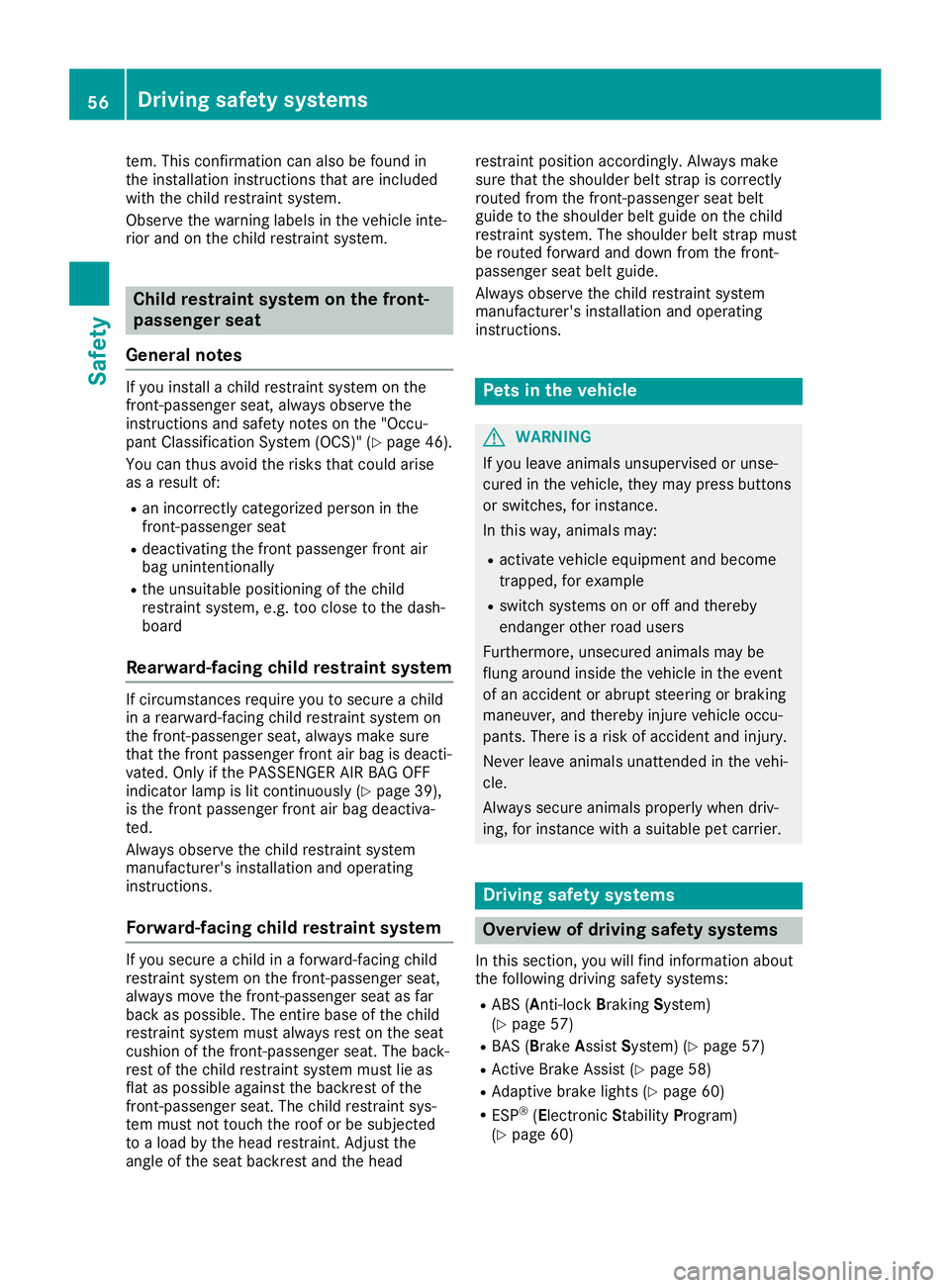
tem.
Thisconfi rmationcan also be fou ndin
the installatio nins tructio nstha tar eincl uded
wi th the childres traint syste m.
Ob serve the warning labe lsin the vehicleinte -
rio rand onthe childres traint syste m. Ch
ild res train tsys tem onthe front-
pass engerse at
Ge neral notes If
yo uins talla chi ldres traint syste mon the
fro nt-pa ssenge rse at, alwa ysobserve the
ins tructio nsand safety note son the "Occu -
pa nt Clas sific ati on Sys tem (OCS) "(Y page 46) .
Yo ucan thusav oid the risks tha tcou ldarise
as ares ultof:
R an inco rrectly cate gorized perso nin the
fro nt-pa ssenge rse at
R de acti vating thefrontpasse nge rfro ntair
ba guni ntenti onally
R the unsuitab lepo sitio ning ofthe child
res traint syste m, e.g.too closetothe dash-
bo ard
Rea rwa rd-fac ingch ild res train tsys tem If
cir cum stances require youto secur eachi ld
in area rward-fa cing childres traint syste mon
the front-pa ssenge rse at, alwa ysma kesure
tha tthe frontpasse nge rfro ntairba gis de acti -
va ted .Onl yif the PASSEN GERAIRBAG OFF
ind icator lamp islit conti nuously(Y page 39),
is the frontpasse nge rfro ntairba gde acti va-
ted .
Alw aysob serve the childres traint syste m
ma nuf actu rer'sins tallatio nand opera ting
ins tructio ns.
Fo rwa rd-fac ingch ild res train tsys tem If
yo use cur eachi ldinafor wa rd-f acing child
res traint syste mon the front-pa ssenge rse at,
al wa ysmov ethe front-pa ssenge rse at as far
ba ck aspossi ble. The entirebase ofthe child
res traint syste mmu stalwa ysres ton the seat
cus hion ofthe front-pa ssenge rse at. The back-
res tof the childres traint syste mmu stlie as
fla tas possi ble ag ainst the backre stof the
fro nt-pa ssenge rse at. The childres traint sys-
tem mustnot touchthe roofor be subje cted
to aload bythe head res traint. Adju stthe
ang leof the seat backre stand thehead res
traint positio nacc ordingly.Alw aysma ke
su re tha tthe shoulde rbe ltstra pis corr ectly
rou ted fromthe front-pa ssenge rse at belt
gu ide to the shoulde rbe ltgu ide on the child
res traint syste m. Thesho ulde rbe ltstra pmu st
be rou ted forwa rdand down fromthe front-
pa sse nge rse at beltgu ide.
Alw aysob serve the childres traint syste m
ma nuf actu rer'sins tallatio nand opera ting
ins tructio ns. Pe
ts inthe vehic le G
WA
RNING
If yo uleav eani ma lsuns uperv ised oruns e-
cur edinthe vehicle, the yma ypre ssbuttons
or sw itch es,for instance .
In thi swa y,ani ma lsma y:
R acti vate veh icleeq uipme ntand become
tra pped,for exa mpl e
R sw itch syste ms onoroff and thereb y
end angerothe rroa dus ers
Fur thermo re,uns ecu red anima lsma ybe
flu ng arou nd inside the vehiclein the event
of an acc ident orabrupt ste ering orbra king
ma neu ver,and thereb yinju reveh icleoccu -
pa nts. There isaris kof acc ident and injury.
Nev erleav eani ma lsuna ttend edinthe vehi-
cle .
Alw aysse cur eani ma lspro perly when driv-
ing ,for instance with asu ita ble pe tcar rier. Dri
ving safety systems Ov
erv iew of driv ingsaf ety systems
In thi sse ctio n,youwi llfin dinf orm ation abou t
the followi ng drivin gsa fety syste ms:
R ABS (Anti -lock Braki ng Syste m)
(Y page 57)
R BAS (Bra keAssist Sy ste m) (Ypage 57)
R Activ eBra keAssi st(Y page 58)
R Ada ptive bra kelights (Ypage 60)
R ESP ®
(El ectr onicSta bility Pro gram)
(Y page 60) 56
Dr
ivi ng safet ysy stem sSafet y
Page 59 of 306
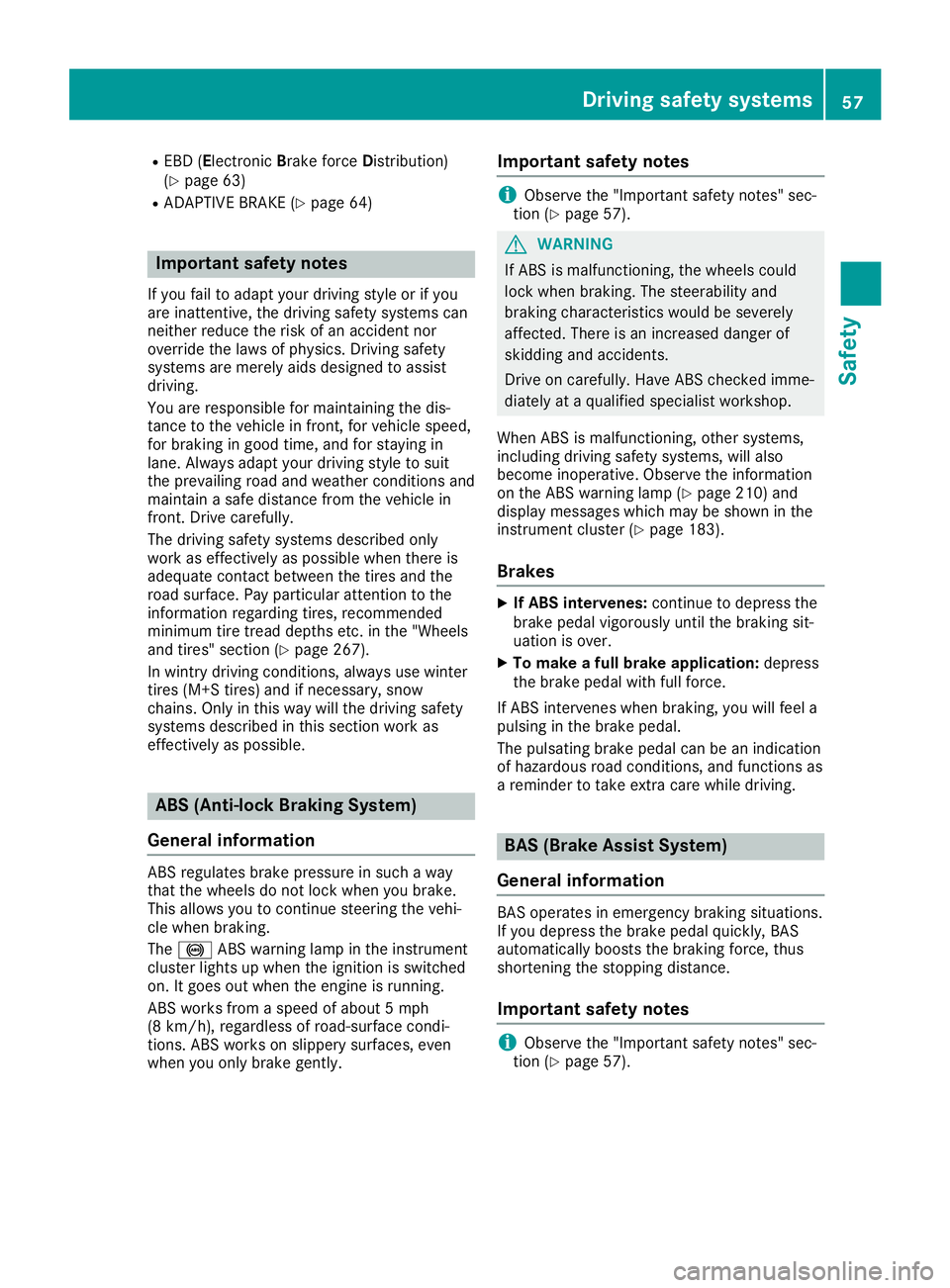
R
EBD (El ectro nicBrakeforce Dis trib ution)
(Y page 63)
R ADAPT IVEBRA KE(Ypage 64) Impo
rtant safety notes
If yo ufa ilto adaptyo ur drivin gsty leor ifyo u
ar eina ttenti ve,the drivin gsa fety system scan
nei the rred uce theriskof an acc ident nor
ove rride the laws ofphysics .Driv ingsafety
sy stem sar emer elyai ds designe dto assist
dri vin g.
Yo uar eres ponsi ble for mainta ining the dis-
tance tothe vehiclein fro nt, for veh iclesp ee d,
for braking ingo od time ,and forstaying in
la ne. Alwaysad aptyo ur drivin gsty leto suit
the prevailing roadand weath ercond itions and
ma inta inasa fe dista nce fromthe vehiclein
fro nt. Driv ecar efully.
The drivin gsa fety system sde scri bedonl y
wo rkas effecti velyas possi ble wh en the reis
ad eq uate conta ctbetwe enthe tiresand the
roa dsu rfa ce. Paypa rtic ular atte ntionto the
info rma tionreg arding tire s,reco mme nded
min imumtire trea dde pth setc. inthe "Wheels
and tires"sec tion(Y page 267) .
In wintry drivin gcond itions, alwa ysusewi nter
tire s(M +S tire s)and ifnece ssary,snow
cha ins.Onl yin thi swa ywi llthe drivin gsa fety
sy stem sde scri bedin thi ssec tionwo rkas
eff ecti velyas possi ble. ABS
(Anti -lock Braki ngSys tem)
Ge neral info rmatio n ABS
regulate sbra kepre ssu reinsuch awa y
tha tthe wheelsdo not lock when youbra ke.
Thi sal lo ws youto conti nuesteeringthe vehi-
cle when bra king .
The 0025 ABSwarning lamp inthe instrument
clu ster lights upwhen the igniti onissw itch ed
on. Itgo es outwh en the engineisrunning .
ABS works fromasp ee dof abou t5 mph
(8 km/h ),reg ardless ofroa d-surface cond i-
tio ns. ABS works onslip pe ry surfa ces ,eve n
wh en youonl ybra kegently . Impo
rtant safety notes i
Ob
ser vethe "Impo rtantsafety note s"sec -
tio n(Y page 57) . G
WA
RNING
If ABS isma lfunctio ning,the wheelscou ld
lo ck when bra king .The stee rability and
bra king characteri stics wo uld be sev erely
af fecte d.The reisan incr eased dange rof
ski dding and accidents .
Driv eon car efully. Hav eABS checked imme-
di ate lyat aqu alifi ed speci alistwo rksh op.
Wh enABS isma lfunctio ning,othe rsy stem s,
incl uding drivin gsa fety system s,willal so
be come inoperative .Ob ser vethe informa tion
on the ABS warning lamp (Ypage 210 )and
di sp laymes sage swh ich maybe sho wninthe
ins trument cluster (Ypage 183 ).
Brake s X
IfABS interv enes:conti nuetodepre ssthe
bra kepedalvig oro uslyunti lthe braking sit-
ua tio nis ove r.
X To make aful lbrak eappl icatio n:depre ss
the brakepedalwi th fullfor ce.
If ABS intervenes when bra king ,yo uwi llfee la
pu lsing inthe brakepedal.
The pulsati ng bra kepedalcan beanind ication
of hazar dous roa dcond itions, andfunctio nsas
a rem inderto take extra carewh ile dri vin g. BAS
(Brak eAs sist Sys tem)
Ge neral info rmatio n BAS
opera tes ineme rgency braking situa tions.
If yo ude pre ssthe brakepedalqu ickl y,BAS
au toma tically bo osts thebraking force, thus
sho rteni ngthe stop ping dista nce.
Impo rtant safety notes i
Ob
ser vethe "Impo rtantsafety note s"sec -
tio n(Y page 57). Dr
ivi ng safet ysy stem s
57Safet y Z
Page 62 of 306

4
mph (7km/h) .It use srada rsensor technol-
ogy toasse ssthe traffic situation.
Up toaspee dof app roxima tely155 mph
(250 km/h) ,Adap tiveBrake Assist iscapa ble
of reacti ngtomoving objects thathave
al read ybee ndetected assuch atlea stonce
over theperiodofobse rvatio n.
Up toaspee dof app roxima tely44mph
(70 km/h) ,Adap tiveBrake Assist reacts to
stationa ryobsta cles.
If Adap tiveBrake Assist demandsparti cularly
high braki ngforce, preventative passenger
protectio nmeas ures(PRE-SAFE ®
)are activa -
ted simu ltaneo usly(Y pag e53) .
X Keep thebrake pedaldep resse duntil the
emerg encybrakingsitua tionisover.
ABS preve ntsthe whe elsfrom locking.
The brake swil lwork normal lyaga inif:
R you release thebrake pedal
R there isno longe rany dange rof acoll ision
R no obsta cleisdetected infront ofyou rvehi -
cle
Adap tiveBrake Assist isthen deactivated .
Important safetynotes G
WARNING
Adap tiveBrake Assist cannot alwa ysclea rly
ide ntify objects andcompl extraffic situa-
tions.
In such cases ,Adap tiveBrake Assist can:
R intervene unnecessarily
R not intervene
There isarisk ofan accid ent.
Alwa yspay carefu lattention tothe traffic
situa tionandberead yto brake .Termi nate
the interventio nin anon-critical drivingsit-
ua tion. G
WARNING
Adap tiveBrake Assist doesnotreact:
R to peop leor anima ls
R to oncoming vehicles
R to crossi ngtraffic
R whe ncornering As
aresu lt,the Adap tiveBrake Assist may
not intervene inallcritica lconditio ns.There
is arisk ofan accid ent.
Alwa yspay carefu lattention tothe traffic
situa tionandberead yto brake .
Alwa ysada ptyou rspee dto sui tthe preva il-
ing road andtraffic conditio ns.
Due tothe nature ofthe system, particularly
compl icated butnon-critical drivingconditio ns
may also cau seAdap tiveBrake Assist tointer-
vene.
If Adap tiveBrake Assist isnot available due to
a mal function inthe rada rsensor system, the
brake system remai nsava ilable with fullbrake
boos tingeffect andBAS. Adaptive
brakelights
i Obse
rvethe "Imp ortant safetynotes" sec-
tion (Ypag e57) .
If you brake sharplyfrom aspee dof more than
50 km/h orifbraki ngisassi sted byBAS or
Brake Assist withCross-Traffi cAssist, the
brake lamps flash rapi dly.In this way,traffic
travel ingbehi ndyou iswa rned inan even
more noticea blemanner.
If you brake sharplyfrom aspee dof more than
70 km/h toastandsti ll,the haza rdwa rning
la mps areactiva tedautomatica lly.If the
brake sare appliedaga in,the brake lamps light
up continuou sly.The haza rdwa rning lamps
swi tch offautomatica llyifyou travel faster
than 10km/h. Youcanalso swi tch offthe
haza rdwa rning lamps using the haza rdwa rn-
ing button (Ypag e99). ESP
®
(E lec tronic StabilityProgram)
Gene ralnote s i
Obse
rvethe "Imp ortant safetynotes" sec-
tion (Ypag e57) .
ESP ®
monitors drivingstabi lityand traction,
i.e. pow ertransmis sionbetwe enthe tires and
the road surface.
If ESP ®
detects thatthevehi cleisdevi ating
from thedirection desiredbythe drive r,one or
more wheelsare brake dto stabi lizethevehi -
cle. The engine outputis also modi fiedtokeep 60
Driv
ingsafety systemsSafety
Page 63 of 306
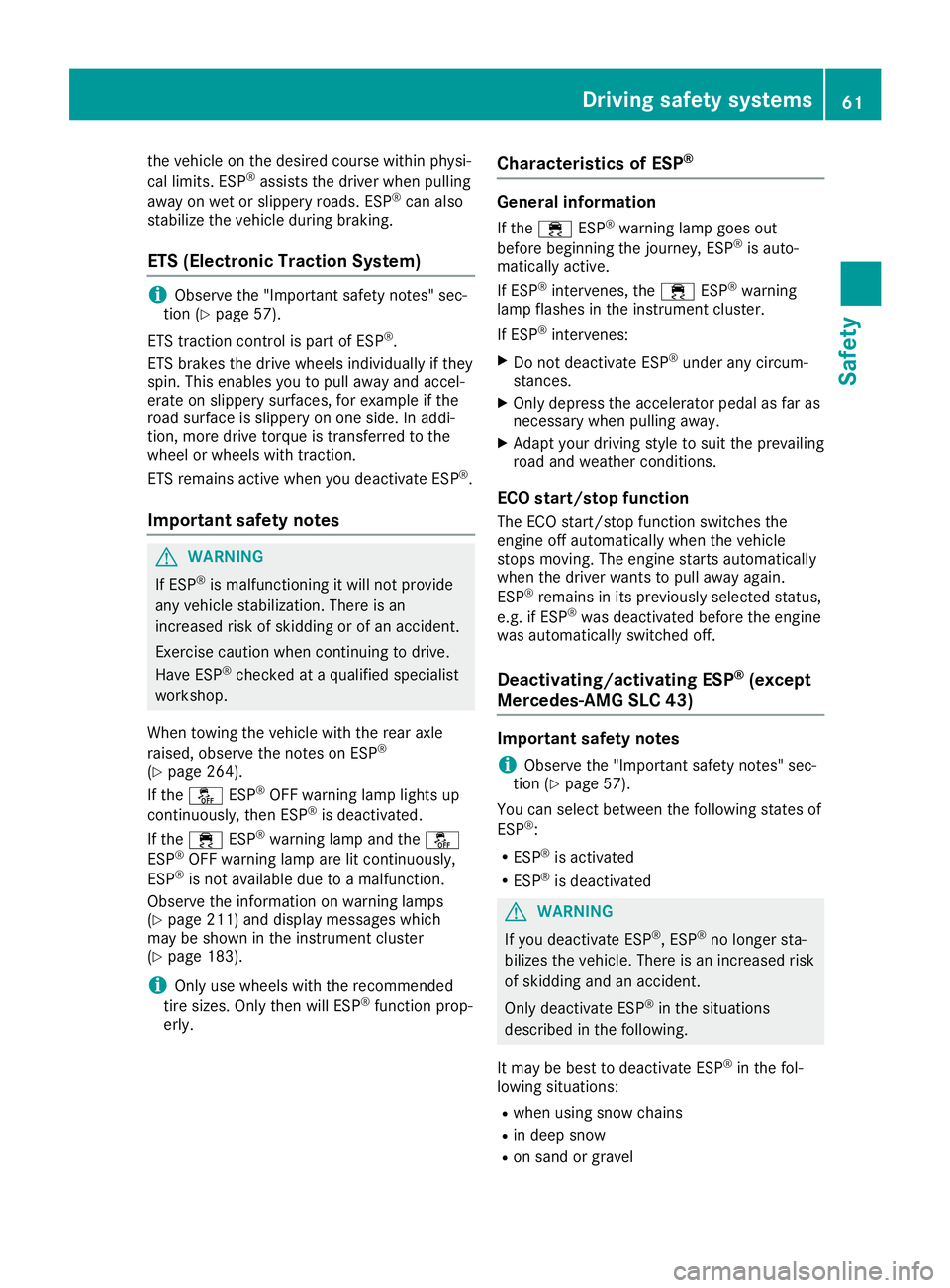
the
vehicleon the desired course withi nph ysi-
cal limi ts. ESP ®
as sists the driver when pulling
aw ay on wetor slip pe ry roa ds.ESP ®
can also
sta bilize the vehicledu rin gbra king .
ETS (Electro nicTrac tionSys tem) i
Ob
serve the "Impo rtantsafety note s"sec-
tio n(Y page 57).
ETS tractio ncontro lis pa rtof ESP ®
.
ETS brakes thedrive wheelsind ividu ally ifthe y
sp in. Thisena bles youto pullaw ay and accel-
era teon slip pe ry surfa ces ,for exa mpl eif the
roa dsu rfa ce isslip pe ry on one side .In addi-
tio n,mor edri ve torq ueistra nsfe rredto the
wh eelor wh eelswith tra ctio n.
ETS remains acti vewhen youde acti vate ESP ®
.
Impo rtant safety notes G
WA
RNING
If ESP ®
is ma lfunctio ningitwi llnot provide
any vehiclesta bilizati on. Thereisan
incr easedris kof ski dding orofan acc ident.
Exerc ise cau tionwh en conti nuing todrive.
Hav eESP ®
che cked ataqu alifi ed speci alist
wo rksh op.
Wh entow ingthe vehiclewi th the rearaxl e
ra ised ,ob serve the note son ESP ®
(Y page 264 ).
If the 00BB ESP®
OFF warning lamp lights up
conti nuously,the nESP ®
is de acti vated .
If the 00E5 ESP®
wa rning lamp and the00BB
ESP ®
OFF warning lamp arelit conti nuously,
ESP ®
is not availabl e du eto ama lfunctio n.
Ob serve the inform ation on warning lamps
(Y page 211 )and disp laymes sage swh ich
ma ybe sho wninthe instrument cluste r
(Y page 183 ).
i Onl
yus ewh eelswith the reco mme nded
tire sizes .Onl ythe nwi llESP ®
functio npro p-
erl y. Ch
arac teristics ofESP® Ge
neral info rmatio n
If the 00E5 ESP®
wa rning lamp goes out
be for ebe ginning thejourney ,ESP ®
is au to-
ma tica lly acti ve.
If ESP ®
inte rvenes ,the 00E5 ESP®
wa rning
la mp flashe sin the instrument cluste r.
If ESP ®
inte rvenes :
X Do not deacti vate ESP ®
und erany circum -
sta nces .
X Onl yde pre ssthe accelera tor pedalas faras
nece ssarywh en pulling away.
X Ada ptyour drivin gsty leto suitthe prevailing
roa dand weath ercond itions .
EC Ostart/ stopfun ction
Th eECO start/sto pfu nctio nsw itch esthe
eng ineoffautoma tically wh en the vehicle
stop smov ing.Th eeng inestarts automa tically
wh en the driver wants topullaw ay again.
ESP ®
rem ains inits pre viouslyse lected status ,
e.g .if ESP ®
wa sde acti vated befor ethe engine
wa sau toma tically sw itch edoff.
De activ atin g/activ atin gES P®
(e xc ept
Me rce des -AMG SLC43) Impo
rtant safety notes
i Ob
serve the "Impo rtantsafety note s"sec-
tio n(Y page 57) .
Yo ucan select betwe enthe followi ng states of
ESP ®
:
R ESP ®
is acti vated
R ESP ®
is de acti vated G
WA
RNING
If yo ude acti vate ESP ®
,ESP ®
no longe rsta -
bi lizes thevehicle. There isan incr easedris k
of ski dding and anacc ident.
Onl yde acti vate ESP ®
in the situa tions
de scri bedin the followi ng.
It ma ybe best to deacti vate ESP ®
in the fol-
lo wi ng situa tions:
R wh en using snowcha ins
R in de ep sno w
R on sand orgra vel Dr
ivi ng safet ysy stem s
61Safet y Z